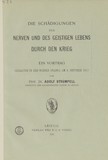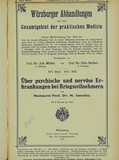War neurotics and military psychiatry
War neurotics and military psychiatry
It is not adequate in light of the severity of the historical moment to make the choice of methodology dependent on aesthetic softness or pseudo-moral concerns.
Ferdinand Kehrer, On the Question of Treating War Neuroses, 1917
The enormous destructive power of the mechanised war left deep traces in the psychology of many soldiers. These traumas, caused for example by burial, artillery fire or by witnessing the most horrific mutilation of comrades, were expressed in many different ways by physical symptoms, despite the body part in question being uninjured. The traumatised often lost some of their senses temporarily, so that they could no longer see or hear. Some lost the ability to speak after they had experienced or seen the most incomprehensible horror.
In many cases, the diagnosis of “war neuroses” led to even more suffering on the part of patients, for the rashly developed “therapies” of the neurologists and psychiatrists were subject to the military orders of medical officers and sometimes involved the use of violence against patients.
Along with initially harmless-seeming measures such as isolation, submersion and cooling packs, from 1915 the so-called Kaufmann Cure was a particularly drastic method that was adapted and extended frequently. Here, patients were maltreated with electric currents, some of them very strong. Doctors attached the electrodes directly to the larynx, eyes, ears or the organs immediately affected by the symptoms. The electrical torture, which lasted between two and five minutes, was joined by the actual suggestive treatment, in other words, the psychiatrist ordered the patient to carry out marching exercises if he was suffering from trembling legs.
In some cases, a metal ball was introduced into the throats of patients suffering from paralysis of the larynx muscles and unable to speak. This closed the airway and interrupted breathing. In the resulting panic the patient was supposed to scream in fear and thus remove the paralysis.
The automatism of the symptoms were therefore to be removed by means of fear, shock and physical pain, and the patient was to be relieved of the advantage of his illness, the protection against being sent to battle at the front. In other words: the soldier was supposed to find the horrors of the front less frightening than the treatment methods of the psychiatrists, thus accelerating his recovery.






